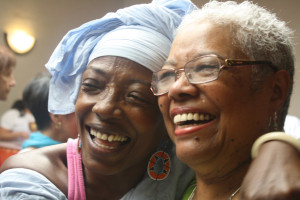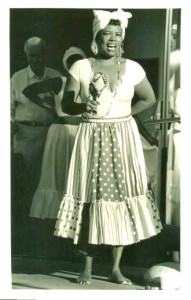“I’VE TRIED TO RETIRE FOUR TIMES,” says Blanche Brown with an infectious laugh, “And I always come back. I just have to dance. I have to listen to those drums.”

At 79, the gracious and engaging Brown remains a vibrant force in the world of dance. And when the San Francisco International Arts Festival presents Congo SQ West Kinship Society on May 28 at the Cowell Theater, she will be the guest of honor in a tribute program featuring Linda Faye Johnson, Marcus Gordon, Roger Dillahunty and next generation artist, Elizabeth Soberanes.
Though she says she didn’t really study dance as a child, Brown says she remembers growing up with music and dance around home.
“I had an aunt who loved to dance—this was in the 1940s,” she relates. “She was good at jitterbug contests and she would always come back and show me the steps she did. So I’ve always had this love for movement and music, but it was definitely about social dance in my family. We always danced when we got together for holidays like Thanksgiving.”
In 1958, then Blanche Vitero, she married a young lawyer named Willie Brown. With his political career on the ascent and three young children, she says that dance was far away from her mind. But as the children grew older, her husband encouraged her to return to school for a college degree and she decided to enroll at San Francisco State University at the age of 35. Initially her focus was a business degree, but she discovered the dance program and was immediately hooked.
“I was the oldest person there!” she exclaims, “Everybody else was really young. But it was really a whole new world opening up for me. Once I started taking the dance classes that was it. I changed my major and graduated with a degree—in P.E., because in those days they didn’t have a dance degree, only a dance emphasis.”
Brown took her first classes with Nontsizi Cayou, a dance educator and cultural activist who was instrumental in the founding of the dance department as well as the Center for African and African American Art and Culture at SF State.
“She was the director of the dance company,” Brown recalls, “I learned so much from her, she really was a mentor. Her vision of what dance was has stuck with me my whole life because it solidified what I felt about dancing. She used to say you dance from inside out—it’s not just movement for movement’s sake. I repeat that phrase all the time to my students.”
When she first went to college, she says, she took modern and jazz classes, but when she had the chance to study with Haitian teacher and choreographer Jean-Leon Destine?, “I knew it was something totally different.”
“The sound of the drums! I had never danced to drums,” she says. While in school, Brown danced with the Wajumbe Performance Ensemble and after graduating, she also taught classes, but she describes a certain restlessness.
“When I first started we did Afro-Haitian,” she recalls, “but it was not really traditional Haitian. It was African movement to drum rhythms. I knew there was something more. Our company traveled to Africa, and there was something more about the dance that was more spiritual and internal and I wanted to learn what that was about.”
Brown began to study in New York taking classes from Haitians and also going to Haitian ceremonies—“in the middle of Manhattan!” she laughs.
“There was dance and drum all night long. The sun would come up and they would still be dancing and drumming,” she says. “I thought ‘This is what this is all about.’ It has a whole different meaning that was very spiritual—you felt that in the people who were singing and dancing. So I would go back every year and study with a woman who became a good friend of mine, Mona Amira, and I would try to learn as much as I could about how the dance and drum worked together.”
“It really showed me how culturally African dance began, what it was for,” she explains. “In that community, they were dancing for spirits. It could have been a celebration of a spirit, it could have been for somebody who needed to have that spirit come down and talk to them. But it was for something.”
Dance also brought Brown to the Yoruba tradition and in the early 80s, she was initi- ated as a priestess of Oshun.
“I was invited to a ceremony of the Yoruba tradition and there was such similarity between what they were doing and what I saw in New York, between the dance, the drum and the community, how they brought spirits down and how it was more than just dance,” she says. “It took me to that place where I felt like if I really wanted to become part of this I would have to delve in and become initiated. When I first ?started, I had a wonderful godfather who showed me that this religion, as old as it was, really belonged in a modern world, that you could still worship the old way, deal in ancient ways, but still live in the world in which we live.”

In 1988, Brown founded her own company, called Roots of Haiti and then later Group Petit La Croix.
“It grew out of my love of being in Wanjumbe,” she says. “I always wanted to have a company of my own, because I loved doing choreography and I loved telling stories. We called it Petit La Croix, because I lived with a Haitian family once and the spirit came down and said, you are my children and the spirit was Baron La Croix, so we became Petit La Croix.”
“I do feel that spirits help me do what I’m supposed to do,” she continues, “and definitely at my age, the fact that I can still dance means that it has to be something more than just physical. When you see me walk, you’d never think that I’d be able to get out on the dance floor, but it’s just something that takes over. It’s so cleansing.”
Having seen the evolution of African dance and Haitian dance over decades, she observes that all art forms have to evolve.
“What I always loved about Haitian dance is the subtlety, the movement through the back and out through the arms,” she says. “Now movement is more dynamic. But I think all dance has changed. It’s more athletic and certain softer movements have just kind of disappeared. Look at So You Think You Can Dance. It’s how many turns you can do and how high you can jump, if you can somersault. I don’t see a lot of the lyrical things anymore, because a lot of what everybody did came out of that subtlety, whether it was in ballet, or jazz or African dance. Maybe one of these days it will go back.”
Still, it’s the future of dance, the students, that lure Brown back into the studio again and again.
“I love when the light comes on in my students, that moment when they get something,” she says. Of the many threads of her dance careers—student, performer, choreographer and teacher, is her teaching that she loves best.
“I don’t think I’m that great of a dancer,” she says with that same infectious laugh. “I’m short and in my mind I think I’m tall, and when I see myself dance, I think, oh my God. But I love to see dance in other people. What brings me back into the studio is the students and that energy in class. As long as I can move I will probably be teaching.”
The interview over, Brown is busy getting ready for the tribute evening. But she calls back with another thought.
“If you have this passion you should never give it up, you should find a way to do it,” she says. “When I started dancing at 35, who knew that I was going to have this long career, and it started out just because I loved to dance—it was a passion. I was able to make it into a lifelong ambition.”

